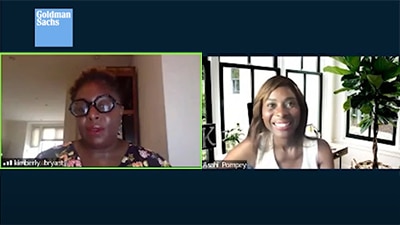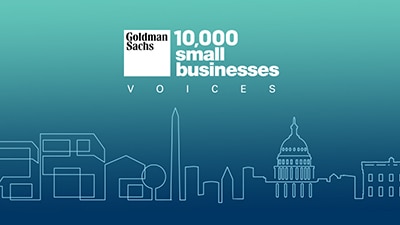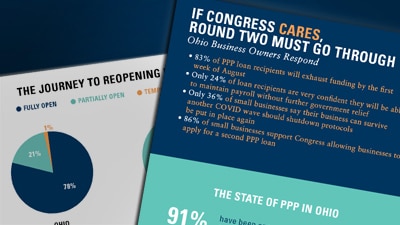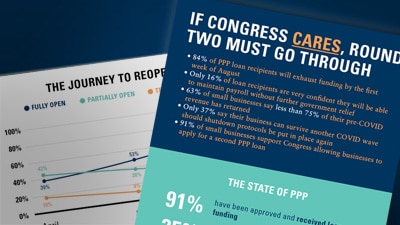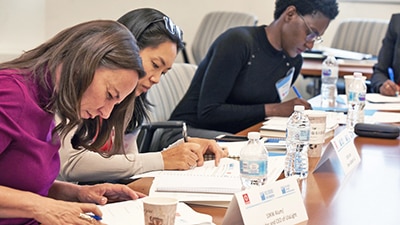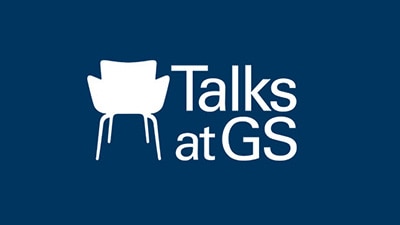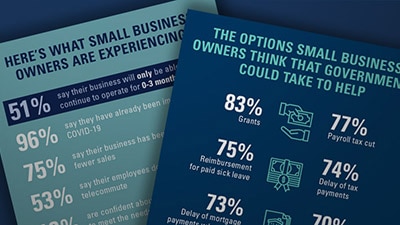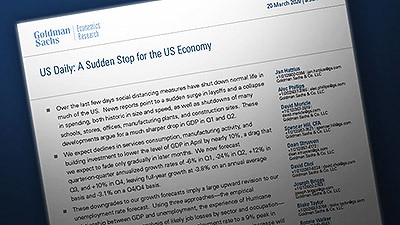Goldman Sachs Announces New Commitment to Support Small Business
Read Press Release
Goldman Sachs Increases Small Business Commitment to $775 Million
Read Press Release
See How We’ve Deployed Capital to Small Businesses Across the U.S.
View Infographic
Goldman Sachs believes small business owners and start-up entrepreneurs fuel the engine of local and national economies all over the world. We are deeply committed to supporting these business leaders during this uncertain time with clear, tangible steps to access capital and additional resources.
Our commercial and philanthropic efforts focused on these communities include our Urban Investment Group, whose work spans comprehensive community and economic development; 10,000 Small Businesses and 10,000 Women which provide education, networking, and access to capital for business owners; and Launch With GS, the firm’s $500 million investment strategy grounded in the belief that diverse teams drive strong returns. Now more than ever we are marshalling our resources, our insights, and our global network to support small businesses struggling with the economic fallout of COVID-19.
Goldman Sachs has committed over $1 billion to help small businesses and communities around the world:
- Support for the Next Generation of the 10,000 Small Businesses Program: A commitment of $250 million in additional funds to ensure the program can reach another 10,000 entrepreneurs with the training and support they need to realize opportunities for growth.
- Small Business Stimulus Package: A $775 million commitment to provide funding and lending to small businesses during this time of stress.
- $750 million to provide emergency loans to small businesses across the country deployed by Community Development Financial Institutions (CDFIs) and other mission-driven lenders
- $25 million in grants to Community Development Financial Institutions (CDFIs) and other mission-driven lenders to ensure they have the necessary capacity to underwrite and deliver loans to small businesses as soon as possible
- $750 million to provide emergency loans to small businesses across the country deployed by Community Development Financial Institutions (CDFIs) and other mission-driven lenders
In addition to our own efforts, we have compiled information and resources to help small businesses navigate accessing capital and support during this unprecedented time.
Note: The below is not comprehensive for all 50 states and local jurisdictions and is intended as a guide. You should consult federal and local community resources for the most up-to-date information.
CARES Act Paycheck Protection Program Loans
The content in this section was last updated on July 6, 2020.
Updates
On Monday, July 6, 2020, the SBA resumed accepting applications for PPP loans at 9:00AM EDT, following the passage of the PPP extension bill which extended the PPP loan program to August 8, 2020. As of July 6, about $130B of $660B appropriated by Congress remained for first time borrowers seeking loans.
Also on Monday, July 6, 2020, the SBA released PPP loan transparency data for loans above $150,000. The released data can be found here.
On Wednesday, June 17, 2020, the SBA issued the Form EZ Loan Forgiveness application, a revised PPP Loan Forgiveness application implementing the PPP Flexibility Act of 2020, which was signed into law on June 5, 2020. This application is an update to the PPP Loan Forgiveness application originally released by SBA on May 15.
Understanding the CARES Act Paycheck Protection Program Loans
For small businesses, the cornerstone of the Coronavirus Aid, Relief, and Economic Security (CARES) Act is the $349 billion Paycheck Protection Program, an emergency lending facility to provide cash-flow assistance to businesses negatively impacted by the COVID-19 pandemic. Federal resources also include Economic Injury Disaster Loans and Emergency EIDL Grants.
What is the Paycheck Protection Program?
- The Paycheck Protection Program provides small businesses with loans that may be partially or fully forgiven, and are 100% federally guaranteed (SBA PPP Loans)
- This program leverages the existing (SBA) 7(a) lending program and current 7(a) lenders, while vastly increasing the available amount, improving loan terms, streamlining borrower requirements, and providing for the expansion of eligible lenders for SBA PPP Loans
- Please note, PPP Loans are available on a first come, first served basis
Who is Eligible?
For-profit businesses, not-for-profit organizations, veterans organizations, and Tribal business concerns that meet the following 3 criteria:
- Are either
a) Entities with fewer than 500 employees or small entities as defined by the SBA; certain industries may have higher maximum employee levels OR
b) sole proprietors, independent contractors and self-employed individuals - Were in operation on February 15, 2020 and had employees for whom you paid salaries and payroll taxes or paid independent contractors
- Will certify, among other things, that the uncertainty of current economic conditions makes the loan necessary to support ongoing operations, and
- Not more than 40% of the proceeds will be used for non-payroll costs
- You understand that if the funds are knowingly used for unauthorized purposes, the federal government may hold you legally liable (such as charges for fraud)
- You will provide to the lender documentation that verifies the number of full-time equivalent employees on payroll and the dollar amounts of payroll costs, covered mortgage interest payments, covered rent payments, and covered utilities for the loan forgiveness period
- You have not and will not receive another loan under this program
- All the information you provided in your application and in all supporting documents and forms is true and accurate (knowingly making a false statement to get a loan under this program is punishable by law)
- You acknowledge that the lender will confirm the eligible loan amount using the documents you submitted
- You understand, acknowledge, and agree that the lender can share the eligible loan amount using required documents submitted (including tax documents) with the SBA’s authorized representatives
With the exception of businesses with a NAICS industry code beginning with 72 (primarily hospitality and food service industries), certain franchise businesses, and businesses that have received investment from an SBIC, a business’s employee count will include the employees of its affiliates (as defined by the SBA). Please refer to the guidance under “What are the Affiliation Restrictions?” below for more information about the Affiliate rules.
Do businesses owned by large companies with adequate sources of liquidity to support the business’s ongoing operations qualify for a PPP loan?
- All borrowers must assess their economic need for a PPP loan under the standard established by the CARES Act and the PPP regulations at the time of the loan application
- Although the CARES Act suspends the ordinary requirement that borrowers must be unable to obtain credit elsewhere (as defined in section 3(h) of the Small Business Act), borrowers still must certify in good faith that their PPP loan request is necessary
- Specifically, before submitting a PPP application, all borrowers should review carefully the required certification that “[c]urrent economic uncertainty makes this loan request necessary to support the ongoing operations of the Applicant.”
- Borrowers must make this certification in good faith, taking into account their current business activity and their ability to access other sources of liquidity sufficient to support their ongoing operations in a manner that is not significantly detrimental to the business
- For example, it is unlikely that a public company with substantial market value and access to capital markets will be able to make the required certification in good faith, and such a company should be prepared to demonstrate to SBA, upon request, the basis for its certification
- Lenders may rely on a borrower’s certification regarding the necessity of the loan request. Any borrower that applied for a PPP loan prior to the issuance of this guidance and repaid the loan in full by May 18, 2020 will be deemed by SBA to have made the required certification in good faith
- If your business, together with your affiliates, received PPP loans with an original principal amount of less than $2 million, you will be deemed to have made the required certification concerning the necessity of the loan request in good faith
What Size is the Loan?
- The maximum loan size is the lesser of (i) $10 million or (ii) 2.5x average total monthly "payroll costs", plus the outstanding amount of an EIDL made between January 31, 2020 and April 3, 2020 (less any advance under an EIDL grant)
How are "Payroll Costs" Defined and Calculated?
- Payroll costs for businesses include salaries, wages, cash tips, payments for vacation, parental, family, medical, or sick leave, and group health care benefits, as well as certain other employment-related expenses
- Payroll costs for sole proprietors and independent contractors includes wages and net earnings from self-employment
- Compensation for an individual employee, sole proprietor or independent contractor above $100,000 annually (pro-rated for the period) is excluded
- The average payroll will be calculated over (i) the year prior to the loan origination, (ii) for seasonal employers, the period between February 15, 2019 through June 30, 2019 or, at the election of the borrower, March 1, 2019 through June 30, 2019, or (iii) the period between January 1, 2020 and February 29, 2020 for businesses not in operation during the period between February 15, 2019 and June 30, 2019
- For additional guidance on how to calculate payroll, please refer to the U.S. Treasury’s Loan Size Calculation Guidance
What Can the SBA PPP Loan Be Used For?
Borrowers are required to make a good faith certification that the loan proceeds will be used for:
- At least 60% of the loan size must be used on payroll costs
- Costs related to the continuation of group health care benefits during periods of paid sick, medical, or family leave, and insurance premiums
- Employee compensation
- Business related mortgage interest payments (not principal), lease payments, utility payments
- Interest on any other business debt obligations that were incurred prior to February 15, 2020
- Refinancing an SBA EIDL loan made between January 31, 2020 and April 3, 2020
- Note: For purposes of determining the percentage of use of proceeds for payroll costs, the amount of any EIDL refinanced will be included (see below)
What is the Loan Forgiveness Covered Period?
- If your PPP loan was made after June 5, 2020, your loan forgiveness “covered period” is the 24-week period beginning on the date your PPP loan is disbursed
- If your PPP loan was made before June 5, 2020, you may elect to have your loan forgiveness covered period be either the 8-week period or 24-week period beginning on the date your PPP loan was disbursed
- What this means: You will owe money when your loan is due if you use the loan proceeds for anything other than payroll costs, mortgage interest, rent, and utilities payments over the 24 weeks (or 8 weeks) after getting the loan
How Much of the SBA PPP Loan Can be Forgiven?
- Loans can be forgiven up to the full principal amount of the loan and any accrued interest. The actual amount of loan forgiveness will depend (in part) on the total amount spent over the applicable “covered period” beginning on the date your PPP loan is disbursed on:
- payroll costs including salary, wages, and tips, up to $100,000 of annualized pay per employee (for 24 weeks, a maximum of $46,154 per individual, or for 8 weeks, a maximum of $15,385 per individual)
- covered benefits for employees (but not owners), including health care expenses, retirement contributions, and state taxes imposed on employee payroll paid by the employer (such as unemployment insurance premiums)
- owner compensation replacement, calculated based on 2019 net profit, with forgiveness of such amounts limited to eight weeks’ worth (8/52) of 2019 net profit (up to $15,385) for an 8-week covered period or 2.5 months’ worth (2.5/12) of 2019 net profit (up to $20,833) for a 24-week covered period, but excluding any qualified sick leave equivalent amount for which a tax credit is claimed
- interest payment on any mortgage incurred prior to February 15 to the extent deductible on Form 1040
- Schedule C (but not any prepayment or payment of principal)
- payment of rent on any lease in force prior to February 15 to the extent they are deductible on Form 1040 Schedule C, and
- payment on any utility of electricity, gas, water, transportation, telephone, or internet access for which service began before February 15 to the extent they are deductible on Form 1040 Schedule C
- You will not be responsible for any loan payment if you use all of the loan proceeds for the above forgivable purposes and employee and compensation levels are maintained
- Note: You will have to document the proceeds used for payroll costs in order to determine the amount of forgiveness
How Do I Request Loan Forgiveness?
Eligible borrowers can use the Form EZ Loan Forgiveness application released by the SBA on June 17, 2020, which requires fewer calculations and less documentation. You are eligible if you are one of the following:
- A self-employed individual, independent contractor or sole proprietor who had no employees at time of PPP loan application and did not include any employee salaries to calculate average monthly payroll
- A borrower that did not reduce salaries or wages of their employees by more than 25% during the covered period as compared to period between January 1, 2020 and March 31, 2020, and did not reduce the number or hours of their employees between January 1, 2020 and the end of the covered period
- A borrower that experienced reductions in business activity as a result of health directives related to COVID-19, and did not reduce the salaries or wages of their employees by more than 25%
- Review the instructions for completing the Form EZ Loan Forgiveness application
What If I Have Already Reduced My Workforce?
- The Paycheck Protection Program is retroactive to February 15, 2020
- This means employers can use the funds to re-hire employees and still benefit from loan forgiveness
- You are exempt from the reduction in loan forgiveness based on a reduction in FTE employees (described above) if either of the following safe harbors applies:
- In good faith, you are able to document that you were unable to operate between February 15, 2020, and the end of the 24-week (or 8-week) covered period at the same level of business activity as before February 15, 2020, due to compliance with federal government requirements established or guidance issued between March 1, 2020 and December 31, 2020, related to the maintenance of standards for sanitation, social distancing, or any other worker or customer safety requirement related to COVID-19; or
- You reduced your FTE employee levels in the period from February 15, 2020 through April 26, 2020, and you then restored your FTE employee levels by no later than December 31, 2020 to your FTE employee levels in your pay period that included February 15, 2020
- Read more in our FAQs about how a reduction in your number of employees impacts your loan forgiveness amount.
What Are Other Key Terms of the Loan?
- Interest rate: 1% annually
- Loan term: 2 years, unless you and your lender mutually agree to extend the maturity of your loan to five years
- If your loan was made on or after June 5, the maturity is five years
- No fees for borrowers
- All borrowers will receive at least 10 months of interest and principal payment deferment
- SBA PPP Loans:
- DO NOT require companies to have been in operation for one year
- DO NOT require a personal guarantee or collateral
- DO NOT explicitly require companies to be profitable
What is the Timing?
- Lenders were permitted to begin processing loans for small businesses and sole proprietorships on April 3, 2020. Lenders were permitted to begin processing loans for self-employed individuals and independent contractors on April 10, 2020
- Loans can be made until August 8, 2020 (Note: this date was updated on July 6, 2020)
- Eligible lenders must participate within this timeframe
- See sample borrower application and borrower factsheet, both released by Treasury on March 31, 2020
Which Lenders Can Make SBA PPP Loans?
- Eligible lenders currently include existing SBA 7(a) program lenders, federally insured depository institutions, federally insured credit unions, and Farm Credit System institutions
- All institutions that are eligible may choose to not participate
- Additional lenders with sufficient qualifications are expected to be added on a rolling basis by the SBA and U.S. Department of the Treasury
What are the Affiliate Restrictions?
- In general, if a private equity or venture capital firm is deemed to “control” your business, you may not be eligible for PPP Loans
- If your business is deemed to be “controlled” by another firm, you must aggregate the number of employees of your business and the controlling firm, along with the employees of any other businesses affiliated with the controlling firm
- In addition to applying any of these affiliation rules, all borrowers that are portfolio companies of a venture capital or private equity fund should carefully review the required certification on the Paycheck Protection Borrower Application Form (SBA Form 2483) stating that “[c]urrent economic uncertainty makes the loan request necessary to support the ongoing operations of the Applicant.”
- If the aggregate number of employees exceeds 500 (or such higher size standard the SBA has set for businesses in the relevant industry), your small business likely cannot take out a loan under the PPP unless an exemption applies
- For example: If you have 300 employees and a venture capital firm “controls” your business, and that venture capital firm controls another business with 300 employees, your aggregate employee count is 600. You would likely be ineligible for a PPP Loan without an exemption
What Businesses are Exempt from the Affiliate Rules?
- If your business qualifies as any of the below, you may be exempt, meaning you can apply for a loan under the PPP as a small business even if you have more than 500 employees when counted with your affiliate(s), including any controlling PE or VC firm
- Affiliate rule exemptions:
- U.S. businesses in the hospitality and restaurant industries that are assigned a North American Industry Classification System (NAICS) code beginning with 72
- U.S. businesses that are SBA recognized franchises
- Eligible franchises can be found through the SBA’s Franchise Directory
- U.S. businesses that receive financial assistance from an SBIC
- Faith-based organizations that are affiliated with another organization if the relationship is based on a religious teaching or belief or otherwise constitutes a part of the exercise of religion
- Additional details regarding exemptions to the affiliate rules can be found in the Treasury Department’s Frequently Asked Questions regarding the PPP (last updated on May 13, 2020)
How is Control Determined?
Control is determined by four tests:
1. Ownership, where an affiliate owns 50% of the voting equity
2. Affiliation arising under stock options, convertible securities, and agreements to merge
3. Management, where the CEO or President of the business also controls the management of one or more other concerns. Note, this can also apply where a single individual or entity that controls the Board of Directors or management of one business also controls the Board of Directors or management of one of more other businesses
4. Identity of interest, where close relatives have identical or substantially identical business or economic interests
- Note on minority investors: Even if a minority investor has a right to vote against an action, this does not necessarily mean they are an affiliate. If the individual investor has the ability unilaterally to block the action, standing alone, that would constitute control and result in affiliation.
- However, the mere fact that a minority investor has the right to vote against an action should not result in control, and thus affiliation.
If my Business is Ineligible for PPP Due to the Affiliate Rules, What Other Options Do I Have?
- You may be eligible for an Economic Injury Disaster Loan (details below) among other options that may be announced in the coming days and weeks. You should consult your counsel regarding controls analysis and other options
Read more about the Affiliation Rules in our FAQ here.
Economic Injury Disaster Loans and Emergency Economic Injury Grants
 The content in this section was last updated on May 18, 2020.
The content in this section was last updated on May 18, 2020.
Emergency Injury Disaster Loans (“EIDLs”) and Emergency Economic Injury Grants (“EIDL Grants”) provide cash assistance for businesses suffering substantial economic injury due to COVID-19 across all 50 states, Washington D.C. and the territories.
Who Is Eligible?
Certain businesses that were in operation on January 31, 2020 that have suffered economic injury due to COVID 19 including:
- Entities with 500 or fewer employees, including businesses, cooperatives, ESOPs, tribal small business concerns, and small agricultural cooperatives
- Businesses with more than 500 employees that meet the applicable size standard for SBA based on industry
- Sole proprietorships and independent contractors
- Private nonprofits (of any size)
- Note: For EIDLs, businesses with 500 or fewer employees do not require the affiliation analysis that may be required for certain businesses under the SBA PPP Loans
- As of May 18, 2020, SBA has resumed processing EIDL applications that were submitted before the portal stopped accepting new applications on April 15, 2020 and will be processing these applications on a first-come, first-served basis.
- As of May 4, 2020, the SBA issued guidance that agricultural businesses are now eligible for SBA’s Economic Injury Disaster Loan (EIDL) and EIDL Advance programs, to provide additional funding for farmers and ranchers and certain other agricultural businesses affected by the Coronavirus (COVID-19) pandemic. SBA is accepting new EIDL and EIDL Advance applications on a limited basis only to provide relief to U.S. agricultural businesses. Learn more about these resources here.
What Can an EIDL Be Used For?
EIDLs are available to pay for expenses that could have been met had the COVID-19 pandemic not occurred, including:
- Payroll costs including paid sick leave to employees
- Increased costs due to supply chain interruptions
- Rent or mortgage payments
- Obligations that cannot be met due to revenue losses
What are the Key Terms of the EIDL?
- Up to $2 million loan amount
- Interest rate of 3.75% annually for small businesses and 2.75% annually for non-profits
- Up to 30-year loan term
- Requires personal guaranty for loan amounts above $200,000
- Submission of tax returns is not required
If I Apply For an EIDL, Can I Also Get an SBA PPP Loan?
- If you received an EIDL loan from January 31, 2020 to April 3, 2020, you can apply for a PPP Loan
- Using your EIDL loan for purposes other than payroll does not affect your eligibility for a PPP loan
- If your EIDL loan was used for payroll costs, your PP loan must be used to refinance your EIDL loan
- Proceeds from any advance up to $10,000 on the EIDL loan will be deducted from the amount of the PPP Loan forgiven
Key Things To Know About EIDL Loans
Under the CARES Act, EIDL provisions have been expanded:
- EIDLs can be approved by the SBA based solely on an applicant’s credit score
- EIDLs of less than $200,000 can be approved without a personal guarantee
- SBA is not requiring real estate collateral and will take a general security interest in business property
- Businesses do not need to have been in business for the one-year period prior to the COVID-19 pandemic
If you applied for an EIDL prior to the COVID-19 national emergency declaration, you may have been denied because your specific geography was not yet eligible. You can now re-apply for an EIDL.
What Is an EIDL Grant?
- An emergency $10,000 cash advance that may be requested during the EIDL application process that SBA will fund within three days of applying for the EIDL
- The EIDL Grant does not need to be repaid, even if the application for the EIDL is denied
- Note: If you obtain both an SBA PPP Loan and an EIDL Grant, the EIDL Grant will be reduced from the amount of forgiveness under the SBA PPP Loan
Who Is Eligible for an EIDL Grant?
- Anyone who is eligible to apply for an EIDL, retroactive to January 31, 2020 to allow those who have already applied for EIDLs to also receive the EIDL Grant
Where Do I Apply?
- As of May 18, 2020, SBA has resumed processing EIDL applications that were submitted before the portal stopped accepting new applications on April 15, 2020 and will be processing these applications on a first-come, first-served basis.
- As of May 4, 2020, the SBA issued guidance that agricultural businesses are now eligible for SBA’s Economic Injury Disaster Loan (EIDL) and EIDL Advance programs, to provide additional funding for farmers and ranchers and certain other agricultural businesses affected by the Coronavirus (COVID-19) pandemic. SBA is accepting new EIDL and EIDL Advance applications on a limited basis only to provide relief to U.S. agricultural businesses. Learn more about these resources here.
For Further Reading
- SBA Resource Guide - English
- SBA Resource Guide - Spanish
- United States Senate Committee on Small Business and Entrepreneurship’s Guide to the CARES Act
For any specific questions about the CARES Act and how it may impact your business, we strongly encourage that you contact your legal counsel.







